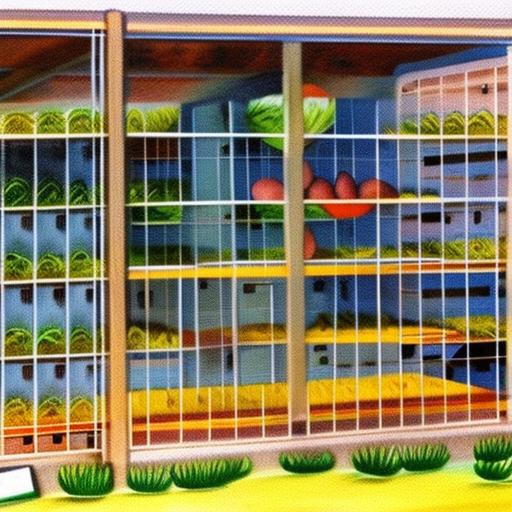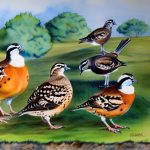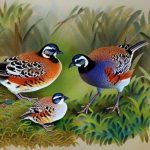Quail layer cages are essential for the successful breeding and production of quails. These cages provide a controlled environment for the quails, ensuring their safety and well-being while also maximizing productivity. The use of layer cages allows for efficient space utilization, as they are designed to accommodate a large number of quails in a relatively small area. This is particularly important for commercial quail breeding operations, where space and efficiency are key factors in ensuring profitability.
Furthermore, quail layer cages provide a clean and hygienic environment for the quails, which is crucial for their health and the quality of the eggs they produce. The cages are designed with easy access to feed and water, as well as removable trays for efficient waste management. This helps to minimize the risk of disease and contamination, ultimately leading to higher egg production and better overall health of the quails. Additionally, the use of layer cages allows for easy monitoring and management of the quails, ensuring that their needs are met and any issues can be addressed promptly.
In summary, quail layer cages are essential for providing a safe, efficient, and hygienic environment for quails, ultimately leading to higher productivity and profitability in breeding operations. Their use is crucial for commercial quail breeding, as well as for small-scale breeders looking to maximize their production in a controlled and sustainable manner.
Key Takeaways
- Quail layer cages are important for providing a safe and comfortable environment for quails to lay eggs and breed.
- Setting up breeding pens for quails requires careful consideration of space, ventilation, and nesting areas to ensure the well-being of the birds.
- Tips for hatching quail eggs include maintaining proper temperature and humidity levels, as well as regular turning of the eggs for optimal hatch rates.
- Choosing the right quail breeding equipment, such as incubators and brooders, is essential for successful breeding and hatching of quail eggs.
- Maintaining cleanliness and hygiene in quail cages is crucial for preventing diseases and ensuring the health of the quail flock.
Setting Up Breeding Pens for Quails
Setting up breeding pens for quails is a crucial step in ensuring successful breeding and egg production. When setting up breeding pens, it is important to consider the space requirements for the quails, as well as their specific needs for nesting, feeding, and watering. The pens should be designed to provide adequate space for the quails to move around comfortably, as well as separate areas for nesting and laying eggs. Additionally, the pens should be equipped with feeders and waterers that are easily accessible to the quails, ensuring that they have constant access to food and water.
Furthermore, it is important to consider the materials used in constructing the breeding pens. The pens should be made of durable and easy-to-clean materials, such as wire mesh or plastic, to ensure a clean and hygienic environment for the quails. Additionally, the pens should be designed with proper ventilation to ensure good air circulation and prevent the buildup of ammonia and other harmful gases. Proper lighting is also important in breeding pens, as it can influence the reproductive behavior of the quails and stimulate egg production.
In conclusion, setting up breeding pens for quails requires careful consideration of space, nesting, feeding, and watering needs, as well as the materials and design of the pens. By providing a comfortable and well-equipped environment for the quails, breeders can ensure optimal breeding conditions and maximize egg production.
Tips for Hatching Quail Eggs
Hatching quail eggs successfully requires careful attention to temperature, humidity, and turning of the eggs. It is important to use a reliable incubator that can maintain a consistent temperature of around 99.5 degrees Fahrenheit and a humidity level of around 60-70% throughout the incubation period. The eggs should be turned regularly, at least three times a day, to prevent the embryos from sticking to the shell membrane and ensure proper development.
Additionally, it is important to monitor the development of the embryos by candling the eggs regularly. Candling involves shining a bright light through the egg to observe the development of the embryo and detect any potential issues such as infertility or early mortality. This allows breeders to remove any non-viable eggs and focus on those that are developing properly.
Furthermore, it is important to handle the eggs with care throughout the incubation process, as rough handling can damage the embryos and reduce hatchability. It is also crucial to maintain a clean and hygienic environment in the incubator to prevent contamination and ensure the health of the developing embryos.
In summary, successful hatching of quail eggs requires careful attention to temperature, humidity, turning, candling, and handling of the eggs. By following these tips, breeders can maximize hatchability and ensure healthy chicks for their breeding operations.
Choosing the Right Quail Breeding Equipment
Choosing the right quail breeding equipment is essential for ensuring the success and efficiency of a breeding operation. When selecting equipment such as incubators, brooders, feeders, waterers, and cages, it is important to consider factors such as quality, durability, ease of use, and suitability for the specific needs of quail breeding.
For example, when choosing an incubator, it is important to select one that can maintain a consistent temperature and humidity level throughout the incubation period. The size of the incubator should also be appropriate for the scale of the breeding operation, ensuring that it can accommodate the desired number of eggs.
Similarly, when selecting brooders for raising quail chicks, it is important to choose ones that provide adequate warmth and space for the chicks to grow and develop. The brooders should also be easy to clean and maintain to ensure a hygienic environment for the chicks.
In addition, when choosing feeders and waterers for quails, it is important to select ones that are designed specifically for quail needs, providing easy access to feed and water while minimizing waste and contamination.
Overall, choosing the right quail breeding equipment requires careful consideration of quality, durability, suitability for specific needs, and ease of use. By selecting high-quality equipment that meets these criteria, breeders can ensure the success and efficiency of their quail breeding operations.
Maintaining Cleanliness and Hygiene in Quail Cages
Maintaining cleanliness and hygiene in quail cages is essential for ensuring the health and well-being of the quails, as well as maximizing productivity in breeding operations. Regular cleaning of cages is crucial for removing waste, preventing disease, and minimizing odor. This can be achieved by regularly removing soiled bedding and replacing it with fresh bedding material. Additionally, cages should be thoroughly cleaned and disinfected on a regular basis to prevent the buildup of harmful bacteria and pathogens.
Furthermore, it is important to ensure proper ventilation in quail cages to prevent the buildup of ammonia and other harmful gases. Good air circulation helps to maintain a healthy environment for the quails and reduces the risk of respiratory issues.
In addition to regular cleaning and disinfection, it is important to monitor the health of the quails closely and address any signs of illness or disease promptly. This may involve isolating sick quails from the rest of the flock to prevent the spread of illness.
Overall, maintaining cleanliness and hygiene in quail cages requires regular cleaning, disinfection, proper ventilation, and close monitoring of quail health. By prioritizing cleanliness and hygiene in breeding operations, breeders can ensure the health and productivity of their quails.
Managing Quail Breeding for Optimal Productivity

Managing quail breeding for optimal productivity requires careful attention to factors such as nutrition, lighting, breeding ratios, and disease prevention. Providing a balanced diet with adequate protein and nutrients is essential for maximizing egg production in quails. This may involve using commercial feed formulated specifically for quail or supplementing with additional protein sources such as mealworms or crickets.
In addition to nutrition, lighting plays a crucial role in stimulating reproductive behavior in quails. Providing 14-16 hours of light per day can help stimulate egg production in quails by mimicking natural daylight patterns.
Furthermore, managing breeding ratios is important for ensuring optimal fertility and hatchability in quails. It is generally recommended to maintain a ratio of one male to every three to five females to ensure successful mating without causing stress or aggression among the birds.
Disease prevention is also crucial for managing quail breeding for optimal productivity. This may involve implementing biosecurity measures to prevent the introduction and spread of disease on the breeding premises. Additionally, regular health checks and vaccinations may be necessary to prevent common diseases such as coccidiosis or respiratory infections.
In summary, managing quail breeding for optimal productivity requires attention to factors such as nutrition, lighting, breeding ratios, and disease prevention. By addressing these factors effectively, breeders can maximize egg production and overall productivity in their quail breeding operations.
Troubleshooting Common Issues in Quail Breeding Pens
Troubleshooting common issues in quail breeding pens requires careful observation, proactive management, and prompt intervention when issues arise. One common issue in quail breeding pens is aggression among birds, particularly among males during mating season. This can lead to stress, injury, or reduced fertility among the birds. To address this issue, breeders may need to separate aggressive birds or adjust breeding ratios to reduce competition among males.
Another common issue in quail breeding pens is poor egg production or low hatchability. This may be caused by factors such as inadequate nutrition, improper lighting conditions, or disease. To troubleshoot this issue, breeders may need to review their feeding program, lighting schedule, or disease prevention measures to identify potential causes and make necessary adjustments.
Additionally, maintaining proper ventilation in quail breeding pens is crucial for preventing respiratory issues among the birds. Poor ventilation can lead to a buildup of ammonia and other harmful gases, which can negatively impact bird health and productivity. Troubleshooting this issue may involve adjusting cage design or ventilation systems to improve air circulation within the pens.
In conclusion, troubleshooting common issues in quail breeding pens requires proactive management and prompt intervention when issues arise. By addressing issues such as aggression among birds, poor egg production or hatchability, and inadequate ventilation effectively, breeders can ensure the health and productivity of their quails.
If you’re interested in quail layer cages, breeding pens, and hatching eggs, you may also want to explore the article on “Renting a Chicken Coop” from Poultry Wizard. This insightful piece discusses the benefits of renting a chicken coop and provides valuable information for those looking to start their own poultry operation. Check it out here.
FAQs
What are quail layer cages?
Quail layer cages are specially designed enclosures used for housing and breeding quail for egg production. These cages are typically equipped with feeding and watering systems, as well as egg collection trays.
What are quail breeding pens?
Quail breeding pens are enclosures used for mating and hatching quail eggs. These pens are designed to provide a suitable environment for quail to lay and incubate their eggs, as well as for the hatched chicks to grow.
What is the purpose of hatching quail eggs?
Hatching quail eggs is done to produce quail chicks for meat or egg production. It is also a way to replenish the quail population for breeding purposes.
What are the benefits of using quail layer cages and breeding pens?
Using quail layer cages and breeding pens helps to efficiently manage and control the breeding and egg production process. It also provides a clean and organized environment for the quail, which can lead to better health and higher egg production.
What should be considered when setting up quail layer cages and breeding pens?
When setting up quail layer cages and breeding pens, factors such as space, ventilation, temperature control, and hygiene should be carefully considered to ensure the well-being and productivity of the quail. Additionally, the cages and pens should be designed to allow easy access for feeding, watering, and egg collection.
Meet Walter, the feathered-friend fanatic of Florida! Nestled in the sunshine state, Walter struts through life with his feathered companions, clucking his way to happiness. With a coop that’s fancier than a five-star hotel, he’s the Don Juan of the chicken world. When he’s not teaching his hens to do the cha-cha, you’ll find him in a heated debate with his prized rooster, Sir Clucks-a-Lot. Walter’s poultry passion is no yolk; he’s the sunny-side-up guy you never knew you needed in your flock of friends!







